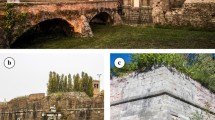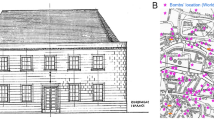Abstract
The travertine buildings of Budapest show extensive black crust formation, which is related to high concentration of atmospheric pollution and a continental climate. Laminar black crusts, framboidal black crusts and leached white surfaces are compared. Physical properties (Schmidt hammer rebound, Duroscope rebound), mineralogical composition and elemental composition are measured. Framboidal black crusts contain more than 50% of acicular gypsum. The crust surface displays idiomorphic rosette-like gypsum crystals with particulates, calcite and gypsum crystal aggregates. The sulphur isotopic composition of the black crusts pinpoints the involvement of rain and dust in crust formation. Thick framboidal black crust has the lowest strength while thin laminar black crust and white dissolved surfaces show minor decrease in surface strength compared to unaltered travertine. The crusts adhere to the travertine surface and rarely show mechanical decay forms that are typical features of porous limestone ashlars in Budapest.











Similar content being viewed by others
References
Airparif (2004) http://www.airparif.asso.fr. Accessed December 2004
Amoroso GG, Fassina V (1983) Stone decay and conservation. Elsevier, Amsterdam, pp 1–453
Antill SJ, Viles HA (1999) Deciphering the impacts of traffic on stone decay in oxford: some preliminary observations from old limestone walls. In: Jones MS, Wakefield RD (eds) Aspects of stone weathering, decay and conservation. Imperial College Press, London pp 28–42
Ausset P, Crovisier JL, Del Monte M, Furlan V, Girardet F, Hammecker C, Jeannette D, Lèfevre A (1996) Experimental study of limestone and sandstone sulphation in polluted realistic conditions: the Lausanne atmospheric simulation Chamber (Lasc). Atmos Environ 30:3197–3207
Ausset P, Del Monte M, Lèfevre RA (1999) Embryonic sulphated black crusts on carbonate rocks in atmospheric simulation chamber and in the field: role of carbonaceous fly-ash. Atmos Environ 33:1525–1534
Bell FG (1993) Durability of carbonate rock as a building stone with comments on its preservation. Environ Geol 21:187–200
Bonazza A, Sabbioni C, Ghedini N (2005) Quantitative data on carbon fractions in interpretation of black crusts and soiling on European built heritage. Atmos Environ 39:2607–2618
Buzek F, Schramek J (1985) Sulfur isotopes in the study of stone monument conservation. Stud Conserv 30:171–176
Camuffo D (1995) Physical weathering of stone. Sci Total Environ 167:1–14
Camuffo D, Del Monte M, Sabbioni C (1983) Origin and growth mechanisms of the sulfated crusts on urban limestone. Water Air Soil Pollut 19:351–359
Camuffo D, Giorio R (2003) Quantitative evaluation of water deposited by dew on monuments. Bound Layer Meteorol 107:665–672
Charola AE, Ware R (2002) Acid deposition and the deterioration of stone: a brief review of a broad topic. In: Siegesmund S, Weiss TS, Vollbrecht A (eds) Natural stones, weathering phenomena, conservation strategies and case studies, special publications 205. Geological Society, London, pp 393–406
Christaras B (1991a) Weathering of natural stones and physical properties. In: Zezza F (ed) Weathering and air pollution. Community of Mediterranean Universities, Bari, pp 169–174
Christaras B (1991b) Durability of building stones and weathering of antiquities in Creta/Greece. Bull Int Assoc Eng Geol 44:17–25
Christaras B (1996) Non destructive methods for investigation of some mechanical properties of natural stones in the protection of monuments. Bull Int Assoc Eng Geol 54:59–63
DEFRA (2004) http://www.defra.gov.uk. Accessed December 2004
Dolske D. (1995) Deposition of atmospheric pollutants to monuments, statues, and buildings. Sci Total Environ 167:15–31
Fassina V, Favaro M, Naccari A (2002) Principal decay patterns on Venetian monuments. In: Siegesmund S, Weiss TS, Vollbrecht A (eds) Natural stones, weathering phenomena, conservation strategies and case studies, special publications 205, Geological Society, London, pp 381–391
Fitzner B, Heinrichs K, Kownatzki R (1995) Weathering forms-classification and mapping. In: Snethlage R (eds) Denkmalpfelge und Naturwissenschaft, Natursteinkonservierung I. Ernst & Sohn, Berlin, pp 41–88
Garcia-Vallès M, Topal T, Vendrell-Saz M (2003) Lichenic growth as a factor in the physical deterioration on protection of Cappadocian monuments. Environ Geol 43:776–781
Goudie AS (2006) The Schmidt hammer in geomorphological research. Prog Phys Geogr 30:703–718
Goudie AS, Viles H (1997) Salt weathering hazards. Wiley, Chichester, pp 1–241
Grab S, van Zyl S, Mulder N (2005) Controls on basalt terrace formation in the eastern Leshoto highlands. Geomorphology 67:473–485
Hüpers A, Müller C, Siegesmund S, Hoppert M, Weiss T, Török Á (2005) Kalksteinverwitterung—die Zitadella und das Parlaments—Gebäude in Budapest. In: Siegesmund S, Auras M, Snethlage R (eds) Stein Zerfall und Konservierung. Edition Leipzig, Leipzig, pp 201–209
Irfan TY, Dearman WR (1978) Engineering classification and index properties of a weathered granite. Bull Int Assoc Eng Geol 17:79–90
Kahraman S (2001) Evaluation of simple methods for assessing the uniaxial compressive strength of rock. Int J Rock Mech Min Sci 38:981–994
Katz O, Reches Z, Roegiers JC (2000) Evaluation of mechanical rock properties using a Schmidt hammer. Int J Rock Mech Min Sci 37:723–728
Kieslinger A (1949) Die steine von Sankt Stephan. Verlag Herold, Wien
Klemm W, Siedel H (2002) Evaluation of the origin of sulphate compounds in building stone by sulphur isotope ratio. In: Siegesmund S, Weiss TS, Vollbrecht A (eds) Natural stones, weathering phenomena, conservation strategies and case studies, special publications 205. Geological Society, London, pp 419–429
Kolaiti E, Papadopoulos Z (1993) Evaluation of Schmidt rebound hammer testing: a critical approach. Bull Int Assoc Eng Geol 48:69–76
Korpás L (2003) Basic pattern of quaternary travertine: a review with special regard to the Hungarian deposits. Acta Geol Hung 46:131–148
Lefévre RA, Ausset P (2002) Atmospheric pollution and building materials: stone and glass. In: Siegesmund S, Weiss TS, Vollbrecht A (eds) Natural stones, weathering phenomena, conservation strategies and case studies, special publications 205. Geological Society, London, pp 329–345
Maravelaki-Kalaitzaki P, Biscontin G (1999) Origin, characteristics and morphology of weathering crusts on Istria stone in Venice. Atmos Environ 33:1699–1709
McAlister JJ, Smith BJ, Török Á (2006) Element partitioning and potential mobility within surface dusts on buildings in a polluted urban environment, Budapest. Atmos Environ 40:6780–6790
MEP (2004) Report on the State of Environment. Ministry of Environmental Protection, Budapest
Moropoulou A, Bisbikou K, Torfs K, Van Grieken R, Zezza F, Macri F (1998) Origin and growth of weathering crusts on ancient marbles in industrial atmosphere. Atmos Environ 32:967–982
Pécsi-Donáth É (1987) Mineralogical and granulometric analysis of the “old loess sequences” of Hungary. In: Pécsi M, French HM (eds) Loess and periglacial phenomena. Akadémiai Kiadó, Budapest, pp 43–50
Pentecost A (1995) The quaternary travertine deposits of Europe and Asia minor. Quaternary Sci Rev 14:1005–1028
Pentecost A (2005) Travertine. Springer, Berlin, pp 1–445
Rodriguez-Navarro C, Sebastian E (1996) Role of particulate matter from vehicle exhaust on porous building stones (limestone) sulfation. Sci Total Environ 187:79–91
Sabbioni C (1995) Contribution of atmospheric deposition to the formation of damage layers. Sci Total Environ 167:49–55
Siegesmund S, Török Á, Hüpers A, Müller C, Klemm W (2007) Mineralogical, geochemical and microfabric evidences of gypsum crusts: a case study from Budapest. Environ Geol 52:358–397
Sindraba I, Krage L, Igaune S, Vitnia I (2002) Corrosion and restoration of travertine and granite in the Freedom Monument (Riga, Latvia). In: Prikryl R, Viles HA (eds) Understanding and managing stone decay. The Carolinum Press, Prague, pp 275–284
Sindraba I, Normandin KC, Cultrone G, Scheffler MJ (2004) Climatological and regional weathering of Roman travertine. In: Prikryl R, Siegel P (eds) Architectural and sculptural stone in cultural landscape. Carolinum Press, Prague, pp 211–228
Smith BJ, Whalley WB, Magee R (1992) Assessment of building stone decay: a geomorphological approach. In: Webster RGM (eds) Stone cleaning and the nature and decay mechanism of stone. Donhead, London, pp 249–257
Smith BJ, Török Á, McAlister JJ, Megarry J (2003) Observations on the factors influencing stability of building stones following contour scaling: a case study of the oolitic limestones from Budapest, Hungary. Build Environ 38:1173–1183
Smith BJ, Viles HA (2006) Rapid catastrophic decay of building limestones: thoughts on causes, effects and consequences. In: Fort R, Alvarez de Buego M, Gomez-Heras M, Vazquez-Calvo C (eds) Heritage weathering and conservation, vol I. Taylor & Francis/Balkema, London, pp 191–197
Török Á (2002a) Oolitic limestone in polluted atmospheric environment in Budapest: weathering phenomena and alterations in physical properties. In: Siegesmund S, Weiss TS, Vollbrecht A (eds) Natural stones, weathering phenomena, conservation strategies and case studies, special publications 205. Geological Society, London, pp 363–37
Török Á (2002b) The influence of wall orientation and lithology on the weathering of ooidal limestone in Budapest, Hungary. In: Prikryl R, Viles HA (eds) Understanding and managing stone decay. The Carolinum Press, Prague, pp 197–208
Török Á (2003a) Surface strength and mineralogy of weathering crusts on limestone buildings in Budapest. Build Environ 38:1185–1192
Török Á (2003b) Facies analysis and genetic interpretation of travertine. Buda Vár-hegy, Hungary. Acta Geol Hung 46:177–193
Török Á (2004) Comparison of the Processes of Decay of Two Limestones in a Polluted Urban Environment. In: Mitchell DJ, Searle DE (eds) Stone deterioration in polluted urban environments. Science Publishers, Enfield, pp 73–92
Török Á (2005) Gypsum-induced decay on the limestone buildings in the urban environment of Budapest. Int J Restor Build Monum 11:71–78
Török Á (2006) Hungarian travertine: Weathering forms and durability. In: Fort R, Alvarez de Buego M, Gomez-Heras M, Vazquez-Calvo C (eds) Heritage weathering and conservation, vol I. Taylor & Francis/Balkema, London, pp 199–204
Török Á, Rozgonyi N (2004) Mineralogy and morphology of salt crusts on porous limestone in urban environment. Environ Geol 46:323–339
Török Á, Weiss T, Hüpers A, Müller C, Siegesmund S (2004) The decay of oolitic limestones controlled by atmospheric pollution: a case study from the Parliament and Citadella in Budapest, Hungary. In: Kwiatkowski D, Löfvendal R (eds) Proceedings of the 10th international congress on deterioration and conservation of stone, vol II. ICOMOS Sweden, Stockholm, pp 947–954
Török Á, Forgó LZ, Vogt T, Löbens S, Siegesmund S, Weiss T (2007a) The influence of lithology and pore-size distribution on the durability of acid volcanic tuffs, Hungary. In: Prykril R, Smith JB (eds) Building stone decay: from diagnosis to conservation, special publications, 271. Geological Society, London, pp 251–260
Török Á, Müller C, Hüpers A, Hoppert M, Siegesmund S, Weiss T (2007b) Differences in texture, physical properties and microbiology of weathering crust and host rock: a case study of the porous limestone of Budapest (Hungary). In: Prykril R, Smith JB (eds) Building stone decay: from diagnosis to conservation, special publications 271. Geological Society, London, pp 261–276
Viles HA (1993) The environmental sensitivity of blistering of limestones walls in oxford, England: a preliminary study. In: Thomas DSG, Allison RJ (eds) Landscape sensitivity. Wiley, Chichester, pp 309–326
Viles HA, Goudie AS (2004) Biofilms and case hardening on sandstones from Al-Quwayra, Jordan. Earth Surf Proc Landf 29:1473–1485
Winkler EM (1970) The importance of air pollution in the corrosion of stone and metals. Eng Geol 1970:327–334
Acknowledgments
I am grateful to two anonymous reviewers whose comments and suggestions helped in improving the quality of this paper. Selected laboratory analyses (XRF, S isotopes) were made within the framework of German—Hungarian Scientific co-operation (DAAD-MÖB project). The help of S. Siegesmund, W. Klemm, L.Z. Forgó and A. Hüpers is appreciated. Kocsányi K. helped in identification of mineral phases during XRD, DTA-DTG analyses. During the field campaign G. Hajnal, Gy. Emszt and E. L Árpás provided assistance. This work was financed by the Hungarian Science Found (OTKA, grant no. K63399).
Author information
Authors and Affiliations
Corresponding author
Rights and permissions
About this article
Cite this article
Török, Á. Black crusts on travertine: factors controlling development and stability. Environ Geol 56, 583–594 (2008). https://doi.org/10.1007/s00254-008-1297-x
Received:
Accepted:
Published:
Issue Date:
DOI: https://doi.org/10.1007/s00254-008-1297-x




